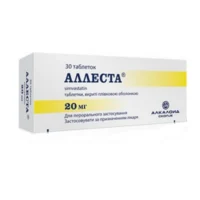Description
Flutan (Flutamide) Tablets 250 mg. №100
Composition
Active Ingredient: Each tablet contains Flutamide 250 mg.
Mechanism of Action
Flutamide, the active ingredient in Flutan tablets, acts as an antiandrogen by inhibiting the action of androgens in the prostate gland. By blocking the effects of male hormones, Flutamide helps to slow the growth of prostate cancer cells.
Pharmacological Properties
Belonging to the class of antiandrogens, Flutamide exerts its therapeutic effects by interfering with androgen activity in the body. This property makes it a valuable component in the management of advanced prostate cancer.
Indications for Use
Flutan (Flutamide) is specifically indicated for the treatment of prostate cancer, particularly in cases where the cancer has advanced or metastasized.
Contraindications
Avoid using Flutan if you have a known allergy to Flutamide or if you are experiencing severe liver impairment. It is crucial to consult with your healthcare provider before initiating treatment with Flutan.
Side Effects
Common side effects of Flutan may include gastrointestinal disturbances, liver function abnormalities, and potential hormonal imbalances. Contact your doctor if you experience any adverse reactions while taking Flutan.
Usage Instructions
The typical dosage regimen involves taking one tablet (250 mg) of Flutan three times daily at 8-hour intervals. Adhere strictly to the prescribed dosage and schedule provided by your physician.
Benefits Over Analogues
Flutan has demonstrated comparable efficacy to other antiandrogen medications while maintaining a favorable side effect profile. Its proven effectiveness in clinical trials and real-world settings makes it a preferred choice for prostate cancer treatment.
Suitable Patient Groups
Flutan is suitable for adult patients, including the elderly, who require treatment for prostate cancer. Pediatric use is not recommended due to the lack of sufficient data on safety and efficacy in children.
Storage and Shelf Life
Store Flutan tablets in a cool, dry place away from direct sunlight. Ensure proper sealing of the packaging to protect the tablets from moisture. Check the expiration date on the packaging and do not use expired medication.
Packaging Description
Each package of Flutan contains 100 tablets, with each tablet encapsulating 250 mg of Flutamide. The packaging is designed to maintain the integrity and potency of the tablets throughout the shelf life.
Clinical Evidence and Effectiveness
Flutamide, in combination with other therapeutic agents, has shown significant efficacy in improving survival rates and enhancing the quality of life in patients with advanced prostate cancer. Notable studies, such as those published in the European Urology journal and the Journal of Clinical Oncology, have underscored the clinical benefits of Flutan in prostate cancer management.





